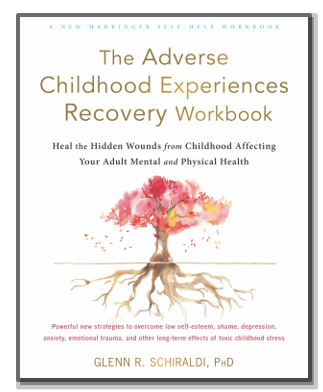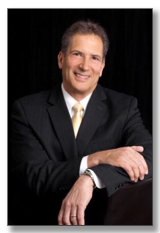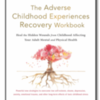A new guide for healing the hidden wounds from ACEs
The Adverse Childhood Experiences Recovery Workbook
Glenn R. Schiraldi, Ph.D.
Oakland, CA: New Harbinger Publications, Inc., 2021, 232 pages
Practical, powerful skills for healing the hidden wounds of childhood trauma
“Dr. Glenn Schiraldi is one of the world’s most trusted experts on stress and resilience. His Adverse Childhood Experiences Recovery Workbook is the most complete, accessible, and evidence-based healing resource available. The ripples of childhood trauma spread throughout our society affecting every facet of life. Thanks to Schiraldi’s stellar work, there is a now a trusted map to recovery available for lay people and helping professionals alike. This workbook is a game changer with the power to heal lives. I can’t recommend it highly enough.”
— Joan Borysenko, PhD, distinguished pioneer in integrative medicine. New York Times best selling author of Minding the Body, Mending the Mind
More than twenty years of research clearly shows that adverse childhood experiences (ACEs) put adults at much greater risk for many, many psychological and medical conditions. ACEs include all types of abuse and neglect, a missing parent, living with someone who is mentally ill or addicted to drugs, and other forms of childhood upheaval. Now there is a practical, powerful guide to heal the hidden wounds caused by ACEs. I’d like to explain how this workbook came to be and tell you a little about its contents.
As a military veteran who specialized in stress, trauma, and resilience at the University of Maryland’s School of Public Health for decades, I’ve observed that adults who appear outwardly normal often carry painful hidden wounds from their earlier years. Knowing that emotional suffering predicts a range of medical illnesses, I developed and tested skills-based courses to reduce such suffering—while also optimizing health and performance. We found that this training reduced symptoms of anxiety, depression, and anger, while increasing resilience, happiness, self-esteem, optimism, and curiosity. In the meantime, I developed a resilience training program for high-risk groups such as cops, firefighters, and the military to prepare them emotionally for the difficult challenges they face. These groups are typically well trained tactically, but not emotionally, and usually have experienced more ACEs than their civilian peers.
During this time, Dr. Vincent Felitti tested the notion that the effects of ACEs accumulate and set people up for enormous suffering in adulthood. Both his and subsequent research have firmly established that ACEs predict myriad disorders, ranging from adult depression, anxiety, drug abuse, ADHD, PTSD, and suicide, to obesity, autoimmune disorders, diabetes, heart disease, and cancer, to name a few. In other words, the common, unresolved inner wounds from childhood adversity are causing untold (and needless) suffering later in life.
People often ask, “Am I stuck with this suffering? Is there anything that can help me feel normal? What can I do to heal? How do I find the right help?” I came to realize that there was a dire need for a clear guide to help people heal those hidden wounds from the early years. People need to know that they do not have to suffer for decades. There are many effective healing and coping skills to try. The Adverse Childhood Experiences Recovery Workbook explains a wide variety of very effective, practical skills. These skills are based on recent findings in neuroscience, attachment, traumatic stress, and resilience—put together under one cover. Recent advances in understanding the brain’s response to traumatic stress indicate that traditional psychological approaches that emphasize thinking and talking are usually not the best starting point for healing. Instead, this workbook first utilizes body-centered and attachment-based imagery strategies before talking/thinking strategies are tried. And when additional help is needed, the workbook shows how to find the right professional help.
What can you expect? Practicing the principles and skills in this workbook is likely to greatly reduce your suffering, improve happiness, and help you improve your mental and physical health and functioning generally. If you are a helping professional, this workbook will give you many powerful tools to help your clients heal.
How is the Workbook Organized?
The first part of the workbook explains the links between ACEs and harmful physical and mental changes. You’ll see that these changes are understandable and normal. You are not crazy. This part also overviews attachment theory and neuroscience. The next part of the book addresses solutions. You’ll:
- Prepare to rewire your brain by optimizing brain health, brain function, and mood. You’ll also learn skills to manage the extremes of stress arousal and disturbing emotions—both of which block healing.
- Strengthen and settle the nervous system that was destabilized by toxic childhood stress. This is accomplished through soothing self-nurturing and attachment imagery, which provides the kindness and comfort that were needed developmentally.
- Use floatback strategies to rewire and settle disturbing childhood memories and beliefs.
- Rework the deeply engrained, visceral experience of shame.
- Create a joyful, fulfilling future.
The good news is that healing and happiness are certainly possible! This workbook shows you the pathways to achieve these goals.
Contents
Introduction 1
PART I: About Adverse Childhood Experiences
Chapter 1 Toxic Stress and Adverse Childhood Experiences 6
Chapter 2 How ACEs Harm the Body: The Mechanisms 18
Chapter 3 How ACEs Shape Psychology 25
PART II: Solutions
About Healing
Chapter 4 The Promise of Healing 44
Self-Care
Chapter 5 Regulate Stress Arousal 54
Chapter 6 Regulate Strong Emotions 60
Chapter 7 Take Care of Your Brain 67
Strengthening and Stabilizing the Nervous System with Imagery
Chapter 8 Attachment Imagery 78
Chapter 9 Self-Nurturing Imagery 84
Chapter 10 Exploring Imagery 88
Chapter 11 Attachment Imagery for Your Teen Years 92
Chapter 12 Comforting Imagery for Difficult Times
Getting to the Bottom of Things: Floatback Strategies
Chapter 13 Floating Back for Disturbing Events 98
Chapter 14 Floating Back to Core Beliefs 105
Reworking Shame
Chapter 15 Shame and Self-Esteem 116
Chapter 16 Rework Shame from Parents 121
Chapter 17 Rework Later Shame Programming 125
Chapter 18 Soften Body Shame 129
Chapter 19 Loving the Body 133
Chapter 20 Healing Inner Dialogue 136
Chapter 21 Disconnect from Memory’s Quicksand 140
Chapter 22 How Would the World Be Different? 146
Chapter 23 Prepare for the Return of Shame 150
Moving Forward
Chapter 24 Cultivate Self-Respect 154
Chapter 25 Forgive Old Wounds 166
Chapter 26 Feed the Soul 173
Chapter 27 Weave Joy into Your Life 180
Chapter 28 Create a New Future 185
Chapter 29 Conclusion 191
Appendix A Skills Record 194
Appendix B Shame Symptoms Inventory 197
Acknowledgments 205
Recommended Resources 207
References 215
“Drawing on his own rich and diverse background and inspired by a variety of treatment approaches, Dr. Glenn Schiraldi has gifted the world a workbook that is destined to be an essential resource for those who have experienced adverse childhood experiences (ACEs), which includes nearly everyone. This engaging, accessible volume is filled with diverse, creative exercises that guide the reader to safely re-visit and heal the effects of the past on brain and body—all the while imparting hope and confidence that dreams of a future that is free of the constraints of the past can become a lived reality. ”
— Pat Ogden, PhD, developer of Sensorimotor Psychotherapy, author: Trauma and the Body and Sensorimotor Psychotherapy: Interventions for Trauma and Attachment
About the Author
Glenn R. Schiraldi, PhD, has served on the stress management faculties at The Pentagon, the International Critical Incident Stress Foundation, and the University of Maryland, where he received the Outstanding Teacher Award in addition to other teaching/service awards. His books on stress-related topics have been translated into sixteen languages, and include The Resilience Workbook, The Post-Traumatic Stress Disorder Sourcebook, and The Self-Esteem Workbook. The founder of Resilience Training International (www.ResilienceFirst.com), he has trained laypersons and clinicians around the world on various aspects of stress, trauma, and resilience.





Comments (0)